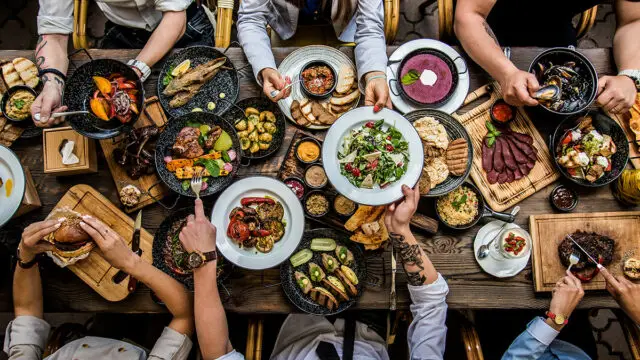Fiber is one of the nutrients we give less importance to. Normally, we only go to her when we have constipation problems. However, it is a fundamental food for our diet and can help us lose weight.
Fiber is also very satiating, so it helps us control the feeling of hunger. And as if that were not enough, it also helps us keep blood sugar levels more stable, thus avoiding glycemic spikes that can lead to attacks of emotional hunger. In addition, a diet rich in fiber helps lower blood fat levels, which protects our cardiovascular health.
What is a diet rich in fiber?
A diet rich in fiber is one where the consumption of foods rich in this nutrient is prioritized. They are usually low carbohydrate diets, but quite flexible. There is no prohibited food, so they are very balanced diets and easy to carry out.
The World Health Organization (WHO) recommends consuming about 25 grams of fiber a day. However, in some diets rich in fiber, such as Factor F, it is recommended to consume about 37 grams of fiber per day.
These types of dietary guidelines are very similar to the Mediterranean diet, since the consumption of fruit, vegetables, whole grains, legumes and nuts is encouraged, which are foods rich in fiber.
What foods are very high in fiber?
Foods rich in fiber are many and varied. This gives us the option of combining them and making very healthy and appetizing recipes. We can stand out:
Oatmeal. 100 grams of oat flakes give you 9 grams of fiber. You have many options to include this food in your diet; there are oat flakes, cereals, flour, etc.
Chia seeds. They have 34 grams of fiber per 100 grams. They are also rich in omega 3 and B vitamins. Try eating them in pudding, with yogurt or in salads.
Popcorn. They provide 15 grams of fiber per 100 grams. They are a rich and healthy snack. We cannot ask for more!
Cooked chickpeas. Dried chickpeas have 15 grams of fiber per 100 grams. It is a very versatile food since you can include it in spoon recipes or as the main ingredient in salads.
Artichoke. It provides 11 grams of fiber per 100 grams. A star food in many diets is that the artichoke has great diuretic properties.
Dark chocolate. It has 10 grams of fiber per 100 grams. Of course, look for one that is not rich in sugars and that has more than 85% cocoa. It really is a delicious and healthy dessert.

What is the fruit richest in fiber?
The fruit richest in fiber is the coconut. According to the Spanish Nutrition Foundation (FEN) it contains 10.5 grams of fiber per 100 grams. The composition of the coconut varies as it matures. Fat is the main component (after water) and is rich in saturated fatty acids.
Coconut is a source of selenium, iron and potassium. Selenium contributes to the maintenance of hair and nails, iron contributes to the normal formation of red blood cells and hemoglobin, and potassium contributes to the maintenance of blood pressure.
What foods have fiber to go to the toilet?
In addition to the foods that we have already discussed, if you have constipation problems you can add to your diet:
Plums. They have a mild laxative effect due to their high content of sorbitol and compounds derived from hydroxyphenylixanthine, a substance that gently stimulates the peristaltic movements of the intestine, which facilitates intestinal transit.
Cherries. They also have an interesting amount of sorbitol and compounds derived from hydroxyphenylixanthine.
Kefir. It is a fermented milk product, similar to yogurt. It is full of probiotics, live bacteria that help improve intestinal transit, among other properties.
In this situation, what can help you is to change the type of fiber you consume. Prioritize the one that comes from fruit and vegetables and not the one from cereals or legumes, because the former gives elasticity to the fecal bolus and facilitates its expulsion.
Here we give you a trick, if you are constipated. You can take 2 glasses of warm water on an empty stomach activates the so-called gastrocolic reflex, that is, it puts the digestive system to work. The stomach gets going and starts moving, and this movement reaches the intestine; the more the bowel moves, the easier it will be to pass the stool.
Precautions when increasing daily fiber intake
Fiber is a nutrient that is resistant to digestion and its absorption in the small intestine; that is to say that our body does not absorb it, so its excessive consumption can cause the drag of other nutrients and cause nutritional deficiencies. It is also recommended that the increase in fiber intake through food be done in a staggered way, since in certain people it can generate certain digestive discomfort.
High fiber diet menu
With a diet rich in fiber you can lose between 1/2 kilo and 1 kilo a week; that is, about 4 kilograms in a month. The dietitian-nutritionist Sara Jiménez proposes this menu:
Monday
Breakfast. Coffee with milk + whole wheat toast with avocado and tomato
Lunch. Grilled salmon with zucchini, mushroom and grated carrot + pear
Dinner. Sautéed green beans with cubes of ham + kiwi
Tuesday
Breakfast. Coffee with milk + multigrain toast with tomato and oil
Meal. Quinoa salad with tomato, onion, pepper, carrot, avocado, cheese and some almonds + a handful of blackberries
Dinner. Scrambled eggs, zucchini and young garlic + banana
Wednesday
Breakfast. Coffee with milk + whole wheat toast with hummus
Meal. Gazpacho + grilled sole with baked potato + apple
Dinner. Grilled turkey breast with sautéed aubergine + pear
Thursday
Breakfast. Coffee with milk + multigrain toast with scrambled egg
Meal. Grilled seitan with mixed vegetable stew + banana
Dinner. Sautéed peas with mushroom, carrot and canned tuna + orange
Friday
Breakfast. Coffee with milk + whole wheat banana toast with cinnamon
Meal. Hake in papillote with ratatouille garnish + a handful of raspberries
Dinner. French omelette with wild asparagus + gazpacho + a handful of blackberries
Saturday
Breakfast. Coffee with milk + multigrain toast with avocado and cheese
Meal. Salmorejo + baked chicken thigh with sweet potato + pear
Dinner. Vegan poke bowl: rice, tomato, onion, pepper, avocado, almonds and sesame seeds
Sunday
Breakfast. Coffee with milk + whole wheat toast with peanut butter and banana
Meal. Baked tofu coated with cornstarch + salmorejo + kiwi
Dinner. Grilled egg + avocado and tomato toast + apple

